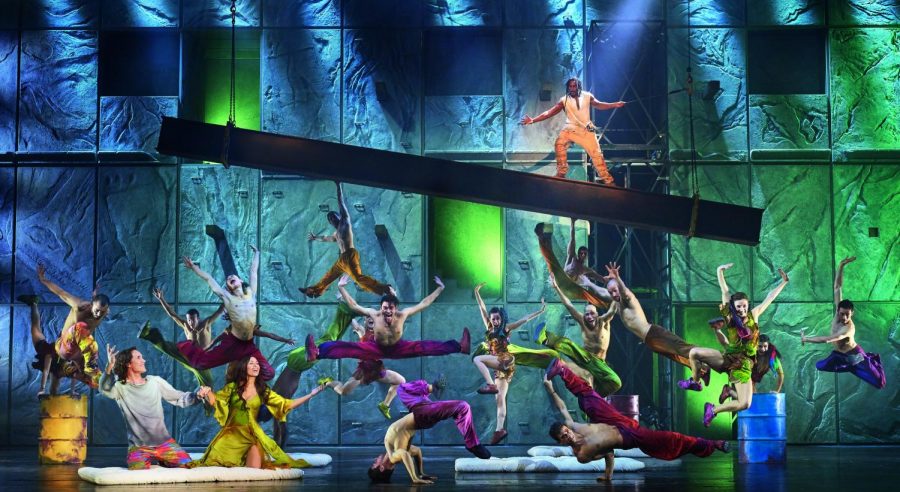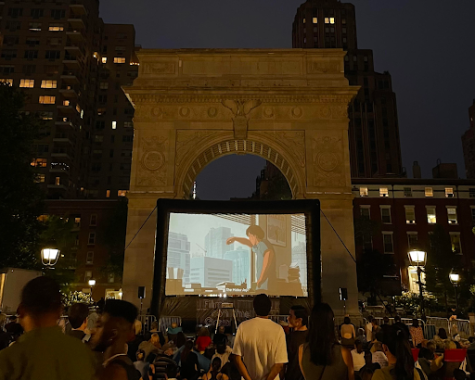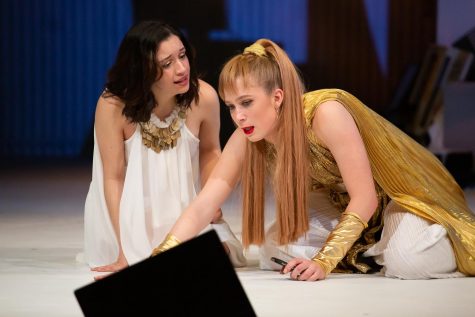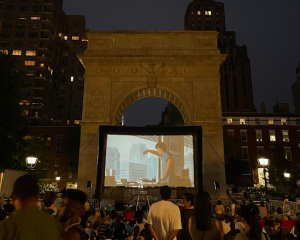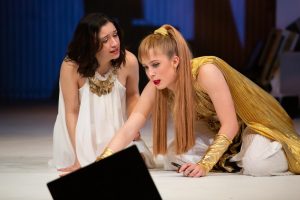‘Notre Dame de Paris’: So Good, It’s Sinful
Though far from the first to sing the praises of this legendary pop-rock musical, its New York debut does not disappoint
COURTESY OF ALESSANDRO DOBICI
“Notre Dame de Paris” at the David H. Koch Theater at Lincoln Center is a pop-rock, sung-through musical following the story of Quasimodo.
July 21, 2022
Lincoln Center, a block away from Fordham’s Manhattan campus, is synonymous with top-tier productions from a variety of performing art traditions. “Notre Dame de Paris” rightfully takes its place among the incredible performances gracing this storied plaza.
“Notre Dame de Paris,” commonly translated as “The Hunchback of Notre Dame,” is a pop-rock, sung-through musical based on Victor Hugo’s eponymous novel.
The story follows Quasimodo (Angelo Del Vecchio), who has a big heart but suffers from several physical deformities, and his attempts to win the love of Esmeralda (Hiba Tawaji), the enchanting bohemian migrant. Esmeralda, in turn, is in love with the cavalry captain Phoebus (Yvan Pedneault), who often drives out the migrants seeking shelter in Paris and is already betrothed to another woman, Fleur-de-Lys (Emma Lépine).
However, not content with a love triangle, there are two other men involved in Esmeralda’s story: Frollo (Daniel Lavoie), Quasimodo’s master and the horny archdeacon of Notre Dame, also falls madly in love with Esmeralda but struggles immensely with his desires — and his xenophobia. But, it is the troubadour and “poet of the streets” Gringoire (Gian Marco Schiaretti) who obtains Esmeralda’s hand in marriage to save himself from execution, though both agree that it is not a union for love. The rest of the story follows the trials and tribulations of these would-be lovers.
The crowds outside of the David H. Koch Theater at Lincoln Center Sunday evening attested to the enduring popularity of adaptations of Victor Hugo’s classic — particularly this version, which holds a Guinness World Record for most successful musical production after selling over one million tickets and three million albums within its first year. Since its premiere in 1998, “Notre Dame de Paris” has captivated audiences in 23 countries spanning Europe, North America, the Middle East and Asia.
July 14, 2022, however, marked the inaugural performance of the musical on New York City’s hallowed stages.
One of the numbers that stood out the most was when Phoebus was trying to choose between his desire for Esmeralda and his duty to Fleur-de-Lys, his betrothed, in “Déchiré.”
The line to pick up tickets from the box office inside the theater stretched so long that the guards monitoring the metal detectors at the doors had to periodically halt new entries to give people within the theater atrium space to move around. At 7 p.m., an older woman with a xylophone moved serenely through the crowd, tapping pleasing tones — the five-minute warning before the start of the show.
Settling into my seat, I surveyed the two columns of stacked pallets and large faux-stone floor-to-curtain top wall at the back of the stage. By 7:05 p.m., the audience’s chatter promptly died down as the lights dimmed, and Gringoire took the stage to set the scene. As he described the changes happening in 1400s Paris, dancers climbed down the giant wall and moved giant stone pillars with gargoyles atop them around the stage, engendering a performance worthy of a Lincoln Center stage.
The leads were phenomenal singers — embodying the often soulful, intense feelings in their songs without abandon. Though the musical was entirely in French (with English supertitles provided on screens at the sides of the stage), it was not difficult to follow along with the story simply by listening to the emotions displayed on the actors’ faces. Understanding of the story was also expressed through the dancers who acted out the internal struggles of the singers.
One of the numbers that stood out the most was when Phoebus was trying to choose between his desire for Esmeralda and his duty to Fleur-de-Lys, his betrothed, in “Déchiré.” The song itself is powerful, from feverish opening notes to the orchestral climax toward the end, but it is the solitary dancers who are periodically top lighted that really make the story shine. Appearing like ghosts — or inner demons — behind a translucent screen and lit by a pale white light, the frenzied, scarcely-clothed dancers writhe and whirl to Phoebus’ angst-ridden vocals.
Though “Déchiré’s” impeccable blocking stood out to me, dancers were often used to embody the stories told by the singers.
During Esmeralda’s “Bohémienne,” several female dancers picked up different parts of her story, twirling around her as she sang about her love for her bohemian roots and lifestyle. Many of the song refrains were kept simple, allowing the story to come less from the words themselves and more from the body language of the dancers and emotions in the vocalists.
The overall effect was breathtaking, and I often found myself clutching the arm of my seat — especially when the acrobats replaced the clappers on Quasimodo’s bells, using their bodies to swing the oversized bells to Quasimodo’s sorrowful rendition of “Les Cloches.”
While the large majority of the show tunes were beautiful ballads, several fast-paced ensemble numbers broke through at crucial moments to move the story along and remind viewers of the powerful theme at the heart of the show: to not fear change, particularly change brought on by the influx of newcomers.
It was during these songs that the director (Gilles Maheu), choreographer (Martine Müller) and set designer (Christian Rätz) worked in perfect harmony to utilize the many talents of the 30-person cast. In many numbers, acrobats free climbed up the wall at the back of the stage and struck daring poses while breakers flipped across the apron, graceful dancers weaving around them. The overall effect was breathtaking, and I often found myself clutching the arm of my seat — especially when the acrobats replaced the clappers on Quasimodo’s bells, using their bodies to swing the oversized bells to Quasimodo’s sorrowful rendition of “Les Cloches.”
My favorite ensemble numbers, however, were those that pitted the guards against the group of migrants, led by the spirited Clopin (Jay). In one of the vicious face-offs between the self-righteous, xenophobic Parisians and the plucky, ragtag team of undocumented migrants (Esmeralda among them), guards swung rolling barricades around the migrants, only for them to gracefully dodge and impede the guards’ advance.
In another number, “Condamnés,” where the calvary attempts to force the undocumented immigrants into a cell, the fight was so beautifully choreographed that it seemed like a ballroom dance, migrants falling into the guards’ arms before being flung back across the stage or ducking sweeping kicks.
“Notre Dame de Paris,” although sharing a language and love of rebellion with the infamous “Les Misérables,” ultimately ends on a sadder note, succumbing more to the woes of love than the hope of a fairer future. But it is a story told with unmatchable intensity and precision, a potent pairing that blew away any expectations I had and left me checking showtimes for the next week. “Notre Dame de Paris” is not a show you will regret seeing.
“Notre Dame de Paris” has strictly limited engagement, with remaining shows running from Thursday, July 21, through Sunday, July 24 at the David H. Koch Theater at Lincoln Center.

